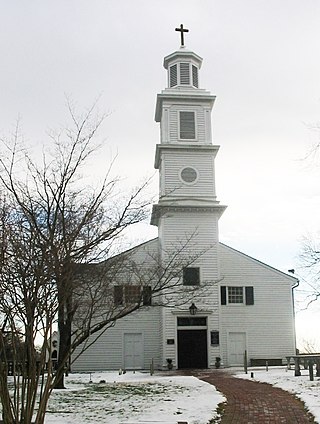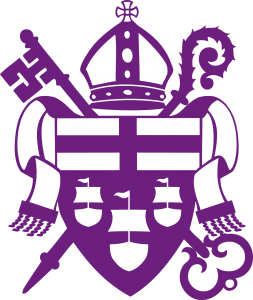Fairfax Parish was the ecclesiastical jurisdiction of the Anglican church in colonial Virginia with jurisdiction over part of Fairfax County with its central church located at The Falls Church. The parish was created in 1764 from Truro Parish.
The Anglican church was the established religion of the Colony of Virginia from 1619 - 1776. [1] Each parish in the colony was ministered to by a single minister and governed by a vestry usually composed of 12 local men of wealth and standing in the community. [1] Parishes were created by acts of the House of Burgesses and the upper house of the legislature, the Governor's Council. [2]
Starting in 1761, residents of the northern reaches of Truro Parish petitioned the Assembly to divide the parish. The Assembly acted in 1764 and created the Fairfax Parish in the areas north of a line "by Doeg creek from the mouth thereof to Mr. George Washington's mill, and from thence, by a straight line, to the plantation, of John Munroe, and the same course continued to the line that divides the counties of Fairfax and Loudoun." [3] It appears that the portion of Truro that remained in that parish was disadvantaged and in 1765 the boundaries were redrawn to place Washington's plantation at Mount Vernon and nearby farms back into Truro.
Drawn over today's civil boundaries, Fairfax Parish would include all of the City of Alexandria, Arlington County, the City of Falls Church, the City of Fairfax, and the western and northern areas of Fairfax County.
The main church was located near the falls line and was called the Falls Church. Christ Church in Alexandria was also a chapel of the parish. In addition, The Glebe of Fairfax Parish were the lands and house set aside for the maintenance of the parish and a dwelling for the minister. They are located in present-day Arlington County, with the current house dating to 1810, after the disestablishment of the church.

Arlington County, or simply Arlington, is a county in the U.S. state of Virginia. The county is located in Northern Virginia on the southwestern bank of the Potomac River directly across from Washington, D.C., the national capital.

Northern Virginia, locally referred to as NOVA or NoVA, comprises several counties and independent cities in the Commonwealth of Virginia in the United States. The region radiates westward and southward from Washington, D.C., the nation's capital, and has a population of 3,257,133 people as of 2023 U.S. Census Bureau estimates, representing over a third of the state's total population. It is the most populous region in both Virginia and the regional Washington metropolitan area.

Truro Anglican Church is an Anglican church in Fairfax, Virginia, USA.

Bruton Parish Church is located in the restored area of Colonial Williamsburg in Williamsburg, Virginia, United States. It was established in 1674 by the consolidation of two previous parishes in the Virginia Colony, and remains an active Episcopal parish. The building, constructed 1711–15, was designated a National Historic Landmark in 1970 as a well-preserved early example of colonial religious architecture.

State Route 120 is a primary state highway in the U.S. state of Virginia. Known as Glebe Road, the state highway runs 9.10 miles (14.65 km) from U.S. Route 1 (US 1) in Crystal City north to SR 123 at the Chain Bridge. SR 120 is a partial circumferential highway in Arlington County that connects the southeastern and northwestern corners of the county with several urban villages along its crescent-shaped path, including Ballston. The state highway also connects all of the major highways in Virginia that radiate from Washington, including Interstate 395, I-66, US 50, and US 29. SR 120 is a part of the National Highway System for its entire length.

St. John's Church is an Episcopal church located at 2401 East Broad Street in Richmond, Virginia, United States. Formed from several earlier parishes, St. John's is the oldest church in the city of Richmond, Virginia. It was built in 1741 by William Randolph's son, Colonel Richard Randolph; the Church Hill district was named for it. It was the site of two important conventions in the period leading to the American Revolutionary War, and is famous as the location where American Founding Father Patrick Henry gave his memorable speech at the Second Virginia Convention, closing with the often-quoted demand, "Give me liberty, or give me death!" The church is designated as a National Historic Landmark.

Fairlington is an unincorporated neighborhood in Arlington County, Virginia, located adjacent to Shirlington in the southernmost part of the county on the boundary with the City of Alexandria. The main thoroughfares are Interstate 395, which divides the neighborhood into North and South Fairlington, State Route 7 and State Route 402.

Buildings, sites, districts, and objects in Virginia listed on the National Register of Historic Places:

The Northern Virginia trolleys were the network of electric streetcars that moved people around the Northern Virginia suburbs of Washington, D.C., from 1892 to 1941. They consisted of six lines operated by up to three companies connecting Rosslyn, Great Falls, Bluemont, Mount Vernon, Fairfax, Camp Humphries, and Nauck across the Potomac River to Washington, D.C.

The Diocese of Virginia is the second largest diocese of the Episcopal Church in the United States of America, encompassing 38 counties in the northern and central parts of the state of Virginia. The diocese was organized in 1785 and is one of the Episcopal Church's nine original dioceses, with origins in colonial Virginia. As of 2018, the diocese has 16 regions with 68,902 members and 180 congregations.

State Route 237 is a primary state highway in the U.S. state of Virginia. The state highway runs 13.07 miles (21.03 km) from SR 236 in Fairfax east to U.S. Route 50 in Arlington. SR 237 connects Fairfax and Arlington with Falls Church. Between Fairfax and Falls Church, the state highway mostly runs concurrently with US 29. East of Falls Church, SR 237 parallels Interstate 66 (I-66) and connects several of Arlington's urban villages.

Christ Church is an Episcopal church located at 118 North Washington Street, with an entrance at 141 North Columbus Street, in Alexandria, Virginia. Constructed as the main church in the Church of England's Fairfax Parish, the building was designed by Col. James Wren, a descendant of Sir Christopher Wren.

The Falls Church is an historic Episcopal church, from which the city of Falls Church, Virginia, near Washington, D.C., takes its name. Established in 1732, the parish in 1769 built a brick church building that remains in use today.

The Northern Neck Proprietary – also called the Northern Neck land grant, Fairfax Proprietary, or Fairfax Grant – was a land grant first contrived by the exiled English King Charles II in 1649 and encompassing all the lands bounded by the Potomac and Rappahannock Rivers in colonial Virginia. This constituted up to 5,000,000 acres (20,000 km2) of Virginia's Northern Neck and a vast area northwest of it.

William Fairfax (1691–1757) was a political appointee of the British Crown in several colonies as well as a planter and politician in the Colony of Virginia. Fairfax served as Collector of Customs in Barbados, Chief Justice and governor of the Bahamas; and Customs agent in Marblehead, Massachusetts, before being reassigned to the Colony of Virginia.

The Falls Church Anglican is an Anglican parish in the Falls Church section of Fairfax County, Virginia, near Washington, D.C. In 2006, the congregation of The Falls Church divided over the question of whether to leave the Episcopal Church, effectively creating two congregations: The Falls Church Anglican and The Falls Church.
In the United States, an independent city is a city that is not in the territory of any county or counties and is considered a primary administrative division of its state. Independent cities are classified by the United States Census Bureau as "county equivalents" and may also have similar governmental powers to a consolidated city-county or a unitary authority. However, in the case of a consolidated city-county, a city and a county were merged into a unified jurisdiction in which the county at least nominally exists to this day, whereas an independent city was legally separated from any county or merged with a county that simultaneously ceased to exist even in name.
Truro Parish was the ecclesiastical jurisdiction of the Anglican church in colonial Virginia with jurisdiction originally over all of Fairfax County. The parish had its central church at the Truro Church and the parish was named for the parish in Truro in Cornwall. The parish was created on November 1, 1732 from Hamilton Parish. It was divided twice: in 1748, Cameron Parish was formed and in 1764 Fairfax Parish was created. After 1765, Truro Parish covered southern Fairfax County until disestablishment ended the parish system by 1786.
Cameron Parish was the ecclesiastical jurisdiction of the Anglican church in colonial Virginia with jurisdiction over the western part of Fairfax County and, once it was created in 1757, over Loudoun County. The parish was named for the minor title of Thomas, Lord Fairfax, Baron of Cameron. The parish was created in 1748 from Truro Parish. It was divided in 1770 and Shelburne Parish was formed from the western half of Loudoun County. After 1770, Cameron Parish covered eastern Loudoun County until disestablishment ended the parish system by 1786.
William Payne was a Virginia gentleman, vestryman, justice, and Fairfax County sheriff in the late colonial period. He was a supporter of the American Independence movement and a member of the Fairfax County Committee for Safety. In 1755, he had a physical altercation with George Washington over an election issue for the Virginia House of Burgesses which almost resulted in a duel. The two became friends serving together in a number of roles later in life. His eldest son was a pallbearer at Washington’s funeral.